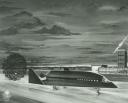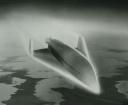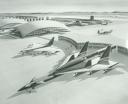A year ago I visited the Bell archives in Niagara, NY. Sadly, my scanner crapped out, so all I had available to me was my camera… better than nothing, but not optimal. Anyway, I found some PR art – paintings and a display model – of a two-stage passenger transport… a turboramjet powered first stage with a rocket powered second stage. Dating from 1960, this concept clearly had some relationship to the earlier BoMi studies (especially Dornbergers passenger transport version), while the second stage was presciently similar to the Dyna Soar and Space Shuttle.
And a few weeks ago I came across a Bell press release describing the concept:
And from Jay Miller’s archives comes a photo of the display model from a different angle.
6 Responses to “Bell two-stage hypersonic transport”
Sorry, the comment form is closed at this time.














The cutaway shows only 30 passenger seats; that’s going to lead to one mighty steep ticket price per passenger when total per-flight operating costs are figured in.
This actually looks like a better concept to use for some sort of long range hypersonic bomber or recon aircraft.
I’ve been thinking about this design, and there are some real problems with the concept as a passenger aircraft.
1.) It only really makes sense for very long range flights, as those maximize the time savings by its speed…so Los Angeles to Tokyo makes sense, but Chicago to Denver doesn’t, particularly given the existence of SSTs like the B-58 based one shown in the background of one of the drawings.
2.) The small passenger capacity gives a clue as to who the intended passengers are… businessmen who need to get from point “A” to “B” ASAP; but the problem with that is how many of those want to go there at exactly the same time? You are counting on quite a few, but not so many as to overload the aircraft… this means that there will be times when its flying almost empty, and the airline has to eat those costs, which will really up ticket prices.
3.) Wherever it goes, it needs some sort of structure to re-mate the upper rocket component to a lower carrier aircraft. It’s sort of the hypersonic equivalent of the Mercury-Maia composite mail aircraft from the 1930s, but at least in that case Mercury could take off on its own if it was empty of cargo and only lightly loaded with fuel for shuttling it around. Here the upper component seem to be entirely dependent on the carrier aircraft to get airborne for any flights. So you can only operate from airports that have a re-mating structure and access to rocket fuel. This isn’t anywhere near as bad as the huge storage hangars that rigid cargo airships needed, but its still a limiting factor on where it will be operated from, as it needs a lot of infrastructure that smaller airports won’t have.
4.) That in turn affects travel time from point “A” to point “B” if either one or both of them aren’t major cities. In that case you have to shuttle from where you are first to the major city where the Bell HST is at, and from the city where it lands to your final destination. Tn a case of some place like Australia which would probably only have two or three airports where these HSTs operate from, that could mean your total time savings might not be that great, as a lot of your travel time will be done on smaller aircraft at one or both ends of the HST trip…so even though you save eight hours travel time on the run from London to Sydney, your total trip time could be a twenty-four hours, so your total time savings will not be all that great for the overall trip, making the very high HST ticket cost of questionable worth.
I’ll leave the problems of sonic booms during the launch aircraft accelerating to separation speed and the passenger part reentering the atmosphere aside, but if laws anywhere near like those in effect today exist, the aircraft is going to be limited to operating from coastal cities.
One would assume that the carrier aircraft would be built in larger numbers than the rocket, such that the SST would be kept in constant service shuttling around cargo and/or lower-paying customers, yet always having one ready to carry the rocket.
I think you’re already aware of my photos of models from the Niagara Aerospace Museum. They represent what seem to be earlier Bell designs for two-stage or three-stage hypersonic aircraft.
http://www.flickr.com/search/?w=76194166%40N00&q=bell+spaceplane&m=text
I have higher-resolution photos if anyone wants them; I also have a couple of more professional photos sent to me by Kathy Lennon Clough.
[…] length 200 feet. It’s unclear if this was a serious engineering design or purely speculative. Paintings and a display model show some notable […]
[…] length 200 feet. It’s unclear if this was a serious engineering design or purely speculative. Paintings and a display model show some notable […]